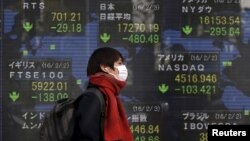Negative interest rates are the new tool in the central banks' collections of monetary policies. They are being tried out by central banks in Japan and Europe, and might come to the United States.
Conventional interest rates reward people who deposit money by paying them additional money, or interest. With negative interest rates, people deposit money, and the bank returns a bit less later on. It is like paying rent to store money.
Advocates of the unconventional policy say it is an effort to boost economic growth by encouraging companies to spend and lend rather than hoard their cash.
Negative rates are also intended to avoid deflation, a downward spiral of falling prices, wages and demand that can damage economies.
"Part of it has to do with a slowdown in general economic activity," Douglas Johnston of Five Management in Santa Monica, California, told VOA.
Many global economies are growing at a frustratingly slow pace. By reducing interest rates "you can presumably boost economic growth, that's one part of it,” he said. “By reducing the interest burden on debt, you can also hope to stimulate the economy."
Side effects
But critics say negative rates have some unwelcome side effects, like damaging the profitability of major banks.
San Diego, California, economist and money manager Bob Lang said negative interest rates mean you basically are paying money to have money in reserve.
"The jury is still out on whether it will work,” he said. “It's generally been considered crisis policy.
"It's not generally a good policy move to have for a long period of time,” Lang added. “It's not anything that's going to stimulate growth in any particular moment, but it could stimulate inflation when you're in a crisis, like we were in 2008-2009, the financial crisis."
‘Uncharted ground’
Bloomberg financial news says that moving to this policy is a sign of "desperation" because it suggests traditional policy options are not working.
But it is also an untested policy.
"The advent of negative interest rates really constitutes something that's never happened in recorded world history," Johnston said. "It's never been tried going back to the days of the Roman Empire or any of the more recent civilizations on Earth. It's never been tried before, but many of the countries and banks involved really felt they didn't have much of a choice."
In the United States, just months after the Federal Reserve increased interest rates for the first time in nine years, Chair Janet Yellen said the Fed has not ruled out imposing negative interest rates if the U.S. economy takes a downward turn.
Currently, about a quarter of the world economy is negative-rate territory.
J.P. Morgan Chase economists say that, in theory, euro rates could drop to negative 4.5 percent. In the U.K., rates could go to negative 2.5 and, if the United States moves into negative rates, economists say it could be as low as 1.3 percent.
"Janet Yellen and others are looking at this and saying, ‘Oh my gosh, you know, we truly are in uncharted ground,'" Johnson said.









